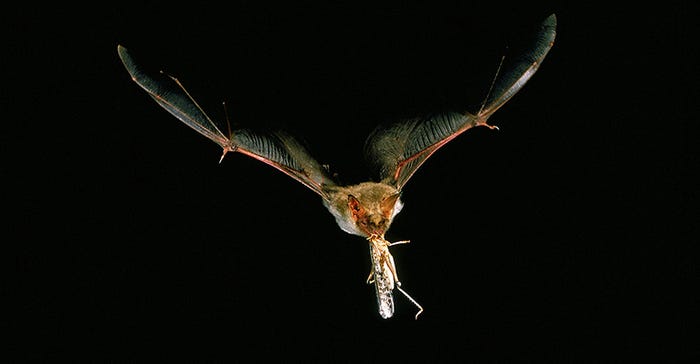Stop lighting up the night. It's hurting bugs and bats—the pollinators
The most effective pollinators work at night, but many don't like artificial light. LEDs are making the problem worse for insects at all stages of life.

Light pollution is making it harder for people to enjoy the night skies: Stars, meteors, comets and even planets are becoming increasingly difficult to see—even impossible in some urban areas.
But that same light pollution is causing bigger problems for animals and insects on our planet. That includes the pollinators on which we rely for food. The journal Nature provides solid background information on this relatively new problem.
A 2017 study by Swiss scientists appears to have been the first to look at pollinators and artificial light. Nature reported the scientists found that pollinators are less likely to visit plants that are under artificial lighting at night. Consequently, the plants—cabbage thistle, in the study—produced less fruit. When plots were located beneath mobile street lamps, insects visited 62% fewer times than when plots situated in darkness, and those that did visit were more homogenous: "The artificially lit plants also saw 29% fewer pollinator species," Jason Bittel wrote in "Nocturnal pollinators go dark under street lamps." Daytime pollinators could not make up the difference because nighttime pollinators transfer pollen more effectively, an author of the study says.
Three recent studies look specifically at how artificial light at night alters the natural environment.
Street lighting has detrimental impacts on local insect populations
Science Advances, published online Aug. 25.
Researchers from the United Kingdom Centre for Ecology & Hydrology in Wallingford; the School of Natural and Environmental Sciences at Newcastle University; and the Butterfly Conservation set out to see whether artificial light is disrupting the behavior of individual insects or actually reducing the overall number of pollinators and insects.
They found far fewer caterpillars in habitats near streetlights, and LED streetlights reduced the population more than high-pressure sodium lights, 52% to 41%. Additionally, caterpillars in areas lit by LEDs were more likely to be heavier than caterpillars from areas lit by high-pressure or low-pressure sodium lights.
"Our results show that entire life cycles, not just single stages (e.g., conspicuous and mobile adult insects), should be considered to better understand the local impacts of biodiversity drivers on insect populations," the authors wrote.
Artificial nighttime lighting impacts visual ecology links between flowers, pollinators and predators
Nature Communications, July 6
Researchers from the University of Exeter's Centre for Ecology & Conservation and Exeter's Environment & Sustainability Institute studied several aspects of the hawkmoth—perception of signals for pollination; sexual signaling; and visual defense against predators.
Artificial lighting falls into three categories: some prevent use of chromatic signals; some closely mimic natural light; and some that have varying effects depending on the intensity and color of the light. Amber LED lighting, which falls into the third group, has unpredictable consequences on the hawkmoth's visual ecology, depending on how far the insect is from the light and the color of what the insect is looking at.
"The diversity of impacts of artificial lighting on hawkmoth visual ecology alone argues for a nuanced approach to outdoor lighting in environmentally sensitive areas, employing intensities and spectra designed to limit those effects of most significant concern," the authors wrote.

Adapting street lighting to limit light pollution's impacts on bats
Global Ecology and Conversation, August 2021
The point of this study was to determine which lighting practices have the least effect on different bat species. The researchers looked at several types of streetlights to understand how height, types of light, brightness and distance are factors in the threat to the bat population. Nine species of aerial bats and six species of clutter bats were included in the study.
Light, especially bright light, reduced the activity of clutter species, probably because the bats perceived it as a higher risk of predators. However, aerial bats were more active near streetlights, likely as a result of more insects in the area.
Higher insect and bat activity near streetlights isn't good, overall, for bats. If streetlights attract more insects, more dark areas will have fewer insects available for the species that avoid the lights. This could lead to having fewer species of bats in the environment.
The authors conclude that since LED and other recent light technologies have reduced the cost of lighting, humans must consider the effects of light pollution on biodiversity before they begin adding streetlights. Three options in managing light pollution are most important: reducing the quantity of light, increasing the directionality of light and avoiding lighting.
About the Author(s)
You May Also Like




